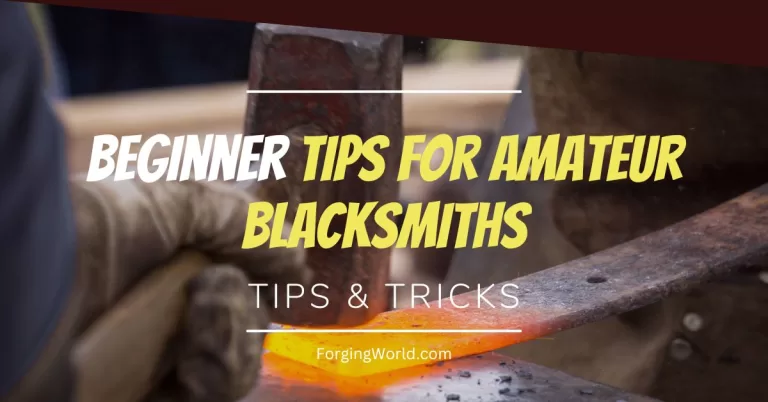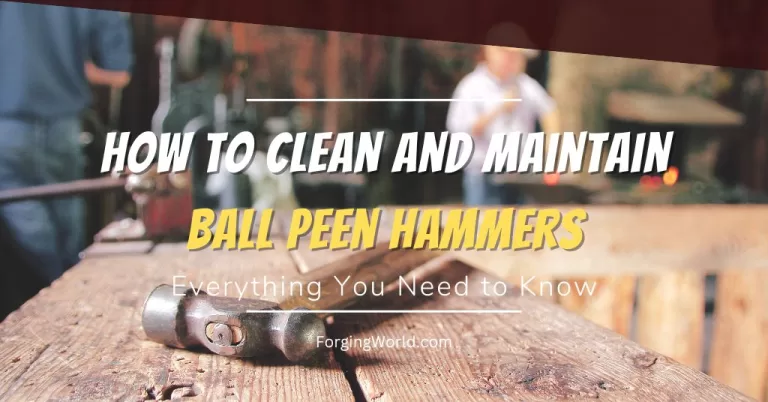If you’re looking for an awesome and practical project to hone your skills, you’ve come to the right place.
Today, we’re going to learn how to forge a bottle opener – a fantastic item to create for yourself, as a gift, or even to sell.
So, let’s get started on this fun and functional journey!
Choosing the Right Steel
First things first, you’ll need to choose the right steel for your bottle opener. There are several types of steel to choose from, but for this project, we recommend using medium carbon steel, like 1045 or 4140.
These steels are strong and durable, perfect for a bottle opener that will last.
You can learn more about different steel types in our article about the best steels for making hammers.
Setting Up Your Forge
Before we dive into forging, make sure your forge is set up and ready to go. A gas or coal forge will work great for this project.
If you’re unsure which type to use, check out our comparison of gas and coal forges. And if you need help setting up your forge, take a look at our guide on how to build a blacksmithing forge.
How to Forge a Bottle Opener
Now that your forge is ready, let’s get down to business. Here’s a step-by-step guide to forging your very own bottle opener:
1. Heat the Steel
Place your steel in the forge and heat it until it reaches a bright orange color, roughly around 2,100°F (1,150°C). This temperature makes the steel more malleable, allowing you to shape and work with it more easily.
2. Draw Out the Steel
Remove the heated steel from the forge using tongs and start drawing it out using your hammer and anvil.
This process involves repeatedly hammering and elongating the steel to create the body of your bottle opener.
Our ultimate guide on how to draw out steel can help you master this technique.
3. Shape the Handle
Once you’ve drawn out the steel to your desired length (usually about 5-6 inches), it’s time to shape the handle.
Taper the end of the steel by hammering it to create a comfortable grip. If you’d like to add a decorative twist or curve, heat the handle area again and use pliers or twisting wrenches to create your desired design.
4. Form the Opener’s Head
Now, move on to the end of the steel opposite the handle. Heat it again and use your hammer and the horn of your anvil to create a small, rounded nub.
This nub will be the part that actually opens the bottle. Ensure that it’s large enough to grip the bottle cap but not too large, as it may not fit under the cap properly.
5. Punch a Hole
Use a punch and a hammer to create a hole near the opener’s head. This hole will allow you to slip the opener over the bottle cap when opening a bottle.
Heat the area where you want the hole and position the punch on the mark. Strike the punch with your hammer until it penetrates the steel.
You can then use a drift to widen the hole, if necessary.
6. Refine the Shape
Heat the steel once more, and use your hammer and anvil to refine the shape of your bottle opener.
Make sure the edges are smooth and the opener is comfortable to hold. You can use a file or grinder to remove any sharp edges or rough spots.
7. Quench and Finish
Once you’re satisfied with the shape of your bottle opener, it’s time to harden the steel by quenching it in oil.
Heat the opener to a bright orange color and then quickly submerge it in your chosen quenching oil. You can learn more about this process and the best quenching oils in our article about why blacksmiths quench in oil.
After quenching, clean your bottle opener using a wire brush and give it a thorough polish with sandpaper or a polishing wheel.
And there you have it—a beautifully forged bottle opener, ready to crack open your favorite beverages!
Tips to Forge a Bottle Opener
As you embark on this blacksmithing journey, here are a few tips to help you succeed:
Safety First
Blacksmithing can be dangerous if you’re not careful. Always wear the proper safety equipment such as safety glasses, ear protection, heat-resistant gloves, and appropriate clothing.
Be sure to follow the 15 most important safety rules to avoid accidents and stay safe while working.
Ask for Help and Advice
Nobody becomes an expert overnight, and even the most skilled blacksmiths started as beginners.
Don’t be afraid to ask for help or advice from more experienced blacksmiths or consult online resources.
Practice Makes Perfect
The more you forge, the better your skills will become. So, keep practicing and try out new techniques and projects.
Don’t be discouraged by initial failures or setbacks—learn from them and keep pushing forward.
Learn Proper Hammering Techniques
Developing good hammer control is essential for successful blacksmithing. Learn and practice proper hammering techniques to ensure that your strikes are effective and accurate.
Our guide on proper hammering techniques can help you master this skill.
Stay Organized and Maintain Your Workspace
A cluttered workspace can lead to accidents and decrease your efficiency. Keep your tools organized and maintain your forge and anvil in good condition.
Regularly clean your workspace, and make sure to keep your tongs, hammers, and other tools within easy reach.
Frequently Asked Questions
What type of steel is best for forging a bottle opener?
For a bottle opener, you can use mild steel or carbon steel. Mild steel is affordable, easy to work with, and readily available, making it an excellent choice for beginners. Carbon steel offers better durability and can be hardened for added strength, but it may be more challenging for beginners to work with.
How long does it take to forge a bottle opener?
The time it takes to forge a bottle opener depends on your skill level and familiarity with the process. For a beginner, it might take a couple of hours to complete a bottle opener, while more experienced blacksmiths may be able to finish one in less than an hour.
Can I forge a bottle opener using only hand tools?
Yes, you can forge a bottle opener using only hand tools like a hammer, anvil, and tongs. While power tools can make the process faster and more efficient, they are not necessary for creating a functional and stylish bottle opener.
Can I personalize my bottle opener?
Absolutely! Forging a bottle opener allows you to create a unique and personalized design. You can add decorative twists, engrave initials, or even shape the handle into a specific form. Use your creativity and imagination to make your bottle opener truly one-of-a-kind.
Do I need to harden and temper the bottle opener?
Hardening and tempering can improve the durability and strength of your bottle opener. However, since bottle openers are not subjected to heavy loads or impacts, hardening and tempering are not strictly necessary. For beginners, simply quenching the bottle opener in oil may be sufficient.
What tools do I need to forge a bottle opener?
To forge a bottle opener, you will need:
- A forge for heating the steel
- An anvil for shaping the steel
- A hammer for striking the steel
- Tongs for holding the hot steel
- A punch and drift for creating the hole
- Pliers or twisting wrenches for adding decorative elements
- Safety equipment, like gloves, safety glasses, and ear protection
- Wire brush, file, or grinder for cleaning and polishing the finished piece
Final Thoughts
Forging a bottle opener is a fantastic project for beginner blacksmiths. It’s not only practical and fun, but it also helps you develop essential blacksmithing skills.
So, grab your hammer and fire up that forge—it’s time to create something amazing!
Remember to take your time, follow our step-by-step guide, and don’t be afraid to ask for help or advice along the way. With some practice and persistence, you’ll be forging bottle openers like a pro in no time. Happy forging!


